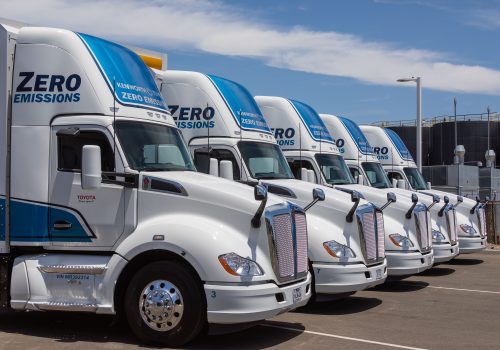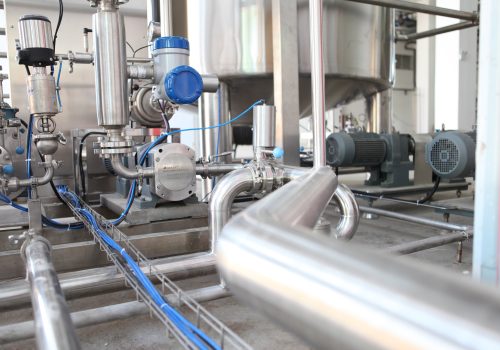This past Friday, October 13, the US Department of Energy (DOE) announced $7 billion in funding for the country’s first clean hydrogen hubs (H2Hubs), as part of the 2021 Bipartisan Infrastructure Law. The announcement represents the single largest public investment in US hydrogen to date and is expected to have a significant impact on the technology’s development. Here are some takeaways from the announcement.
1. California and Texas are the epicenters of US clean hydrogen
California and Texas earned the highest federal cost shares of up to $1.2 billion each from the DOE award. The large amounts are not surprising given the states’ massive clean energy potential and scale; they are the country’s largest states by population, GDP, and—crucially—electricity consumption.
More importantly, the two states have excellent solar and wind resources, which optimizes the economics for producing green hydrogen from renewable electricity. When electrolyzers are sited close to both solar arrays and wind turbines, they can draw from electricity produced from either energy source as it becomes available.
Moreover, Texas’ ample natural gas production and carbon capture potential will likely ensure its leadership in blue hydrogen, which is produced from natural gas with emissions abated via carbon management.
2. The DOE sees a future for blue hydrogen
The DOE’s decision to support four hubs that will produce hydrogen from natural gas is a surprise for some. While the strategy could stand up a new industry and sidestep electrical grid constraints for producing green hydrogen, the decision comes with risks that will require structured oversight to avoid subsidizing emissions. Producing clean hydrogen from fossil feedstock will require the coordination of the upstream sector to deliver cleanly produced natural gas and technology to capture the carbon from gas-based hydrogen production at a sufficient rate.
Abating emissions from hydrogen produced with US natural gas will be challenging. Making hydrogen from natural gas, which in the United States has an average methane intensity of 1.5 percent, will yield 2.5 kilograms of carbon dioxide equivalent (CO2e) emissions per kilogram of hydrogen produced. Even this number assumes the system will capture 100 percent of the carbon dioxide that the process generates, which remains technically challenging. This level of emissions would not meet DOE’s definition of clean hydrogen, set at less than 2 kg CO2e. To meet this standard, hydrogen will have to come from natural gas with near-zero methane emissions, and utilize carbon capture process with greater than 90 percent capture.
To be clear, hydrogen from all feedstocks will be required to scale clean hydrogen to the volumes needed to support the decarbonization of industry, transportation, and other sectors by midcentury—potentially 500 million tons per year or more. Still, hydrogen from fossil feedstock with carbon capture can help alleviate renewable energy bottlenecks, preserve and create jobs, and benefit domestic industry.
3. Hydrogen for long-haul trucking remains a missed opportunity
Increasingly, policymakers regard hydrogen for long-haul trucking and heavy-duty transportation as a highly promising use case. The DOE’s hub selection briefing shows that six out of the seven hubs list long-haul trucking, heavy duty transportation, or both, as potential applications for their hydrogen. In fact, long-haul trucking receives more mentions in the longer-form description than any other potential use case, including ammonia, fertilizers, steel, and refining.
Despite the clear potential for this hydrogen application, the DOE’s hub funding overlooks a key trucking node.
States inland from California—the state which is home to the nation’s largest container ports by volume—will require refueling infrastructure if long-haul hydrogen is to enable the transport of those goods eastward. But the application for the Western Interstate Hydrogen Hub, which included Colorado, New Mexico, Utah, and Wyoming, did not receive funding from the DOE’s initial award. A lack of refueling infrastructure along the east-bound trucking corridor from California threatens to slow development of national long-haul trucking efforts.
4. The use case that dares not speak its name: Hydrogen for oil refining
Oil refineries currently use unabated hydrogen to lower the sulfur content of diesel and account for one-third of world hydrogen consumption. Clean hydrogen could therefore substantially reduce emissions at refineries. However, clean hydrogen for oil refining appears to be a taboo subject in the DOE award.
This is clear from the announcement regarding the Gulf Coast Hydrogen Hub, which is centered in Houston, the country’s most important refinery hub. The DOE’s executive summary of the award does not mention that the Gulf Coast will deploy clean hydrogen to its oil refineries. In a more detailed fact sheet, the DOE does envision that the region will employ hydrogen for refining—but the use case is listed after fuel cell electric trucks, industrial processes, and ammonia, rather than oil production.
The politics of using clean technology to produce hydrocarbons remain fraught.
The most strident voices in climate believe any US oil production is undesirable. Even more pragmatic climate hawks feel uncomfortable abating, rather than eliminating, hydrocarbons. Consequently, climate campaigners of all stripes regard the use of clean hydrogen in refineries ambivalently, at best.
Similarly, some actors in the oil and gas complex are deeply opposed to alternative energy sources in the interest of sustaining demand for their own products. Others go so far as to assert that climate change is a myth. These hydrocarbon hardliners will seek to slow the shift to clean hydrogen at refineries.
While clean hydrogen uptake at refineries will likely accelerate due to funding from the infrastructure law as well as from the Inflation Reduction Act (IRA), the DOE’s award suggests that the complex political economy of clean hydrogen at refineries may constrain its uptake.
Recommendations for policymakers
Hub governance structures
Policymakers can support the establishment of governance structures that coordinate hub implementation, facilitate the hubs’ growth through additional investment, and provide quality assurance. In the case of hydrogen produced from fossil fuel feedstock, quality assurance programs should ensure that project partners use natural gas produced with near-zero methane emissions, capture carbon at sufficiently high rates, and store captured carbon permanently.
Long-haul trucking
Given the DOE’s evident interest in facilitating a long-haul trucking economy, we recommend that it and other state and national-level agencies systematically identify optimal routes and potential stumbling blocks such as hydrogen refueling gaps. They should also determine hydrogen safety standards, including for tunnels. Furthermore, the DOE should consider creating a hydrogen trucking “czar” to coordinate US efforts.
H2Hub funding
While the IRA will incentivize cheap hydrogen production, certain projects are not financeable even under the program’s fiscal incentives, particularly on the demand-side, given the IRA subsidy’s focus on the supply-side. Accordingly, H2Hub funding—derived from the Bipartisan Infrastructure Law—should prioritize cost sharing for demand-side projects.
Emissions reductions
The politics of clean hydrogen for refining applications is admittedly complicated. Still, policymakers need to articulate how eliminating methane emissions, managing carbon, and using clean hydrogen at refineries will go a long way towards moving oil and gas towards operational net zero.
Conclusion
The DOE’s hydrogen hub award represents the single largest public investment in US clean hydrogen and marks an important step in reducing emissions in hard-to-decarbonize sectors. While more needs to be done, the United States’ public and—more importantly—private sector investments demonstrate its leading role in developing the world’s clean hydrogen. These investments will create economies of scale and lower equipment and capital costs worldwide.
Joseph Webster is a senior fellow at the Atlantic Council Global Energy Center
William Tobin is an assistant director at the Atlantic Council Global Energy Center
Meet the authors
Related content
Learn more about the Global Energy Center

The Global Energy Center develops and promotes pragmatic and nonpartisan policy solutions designed to advance global energy security, enhance economic opportunity, and accelerate pathways to net-zero emissions.
Image: LA. (USA CC0) https://www.rawpixel.com/image/5923970






